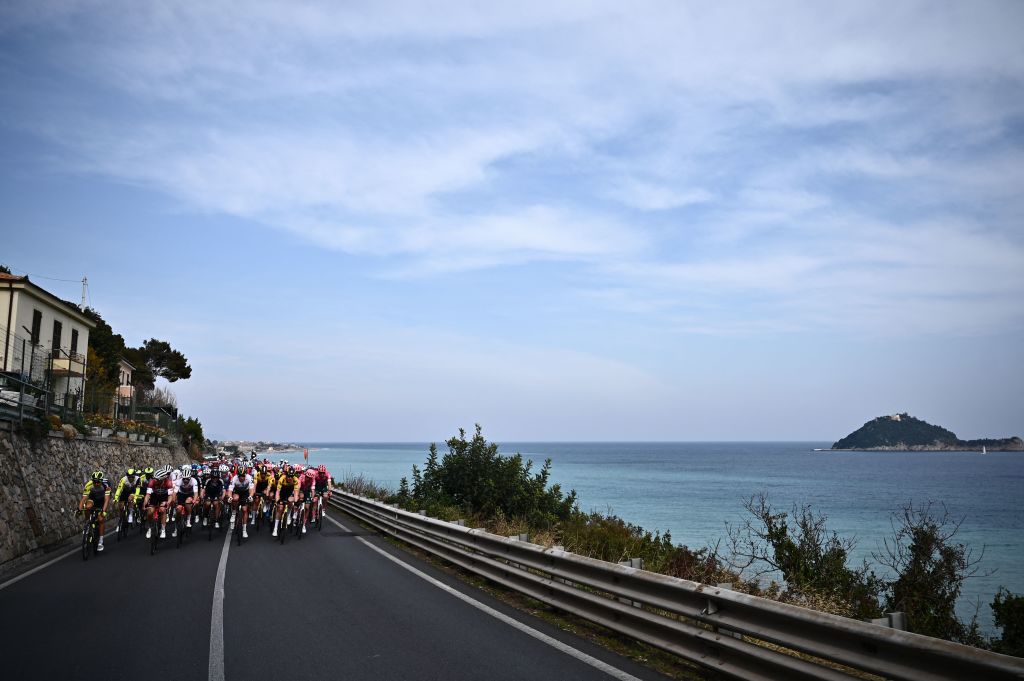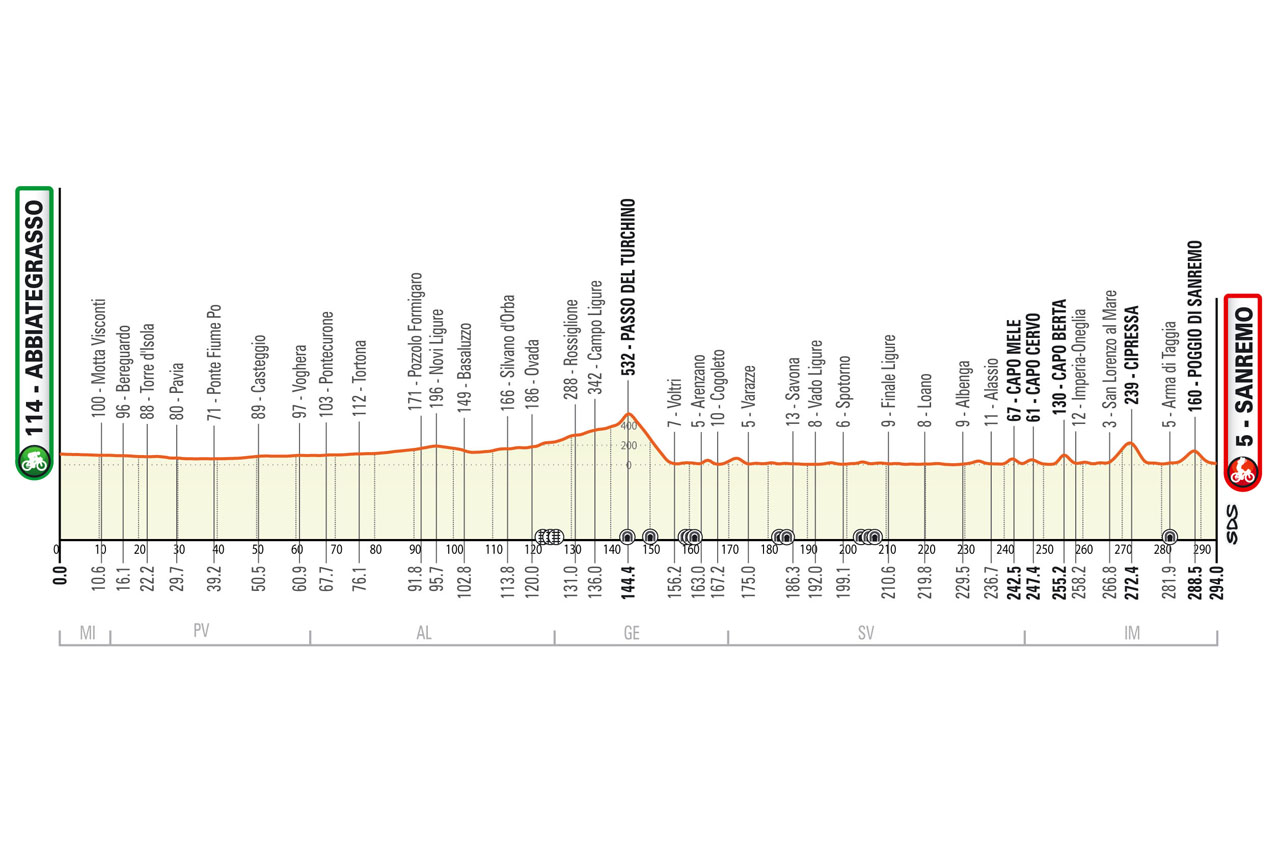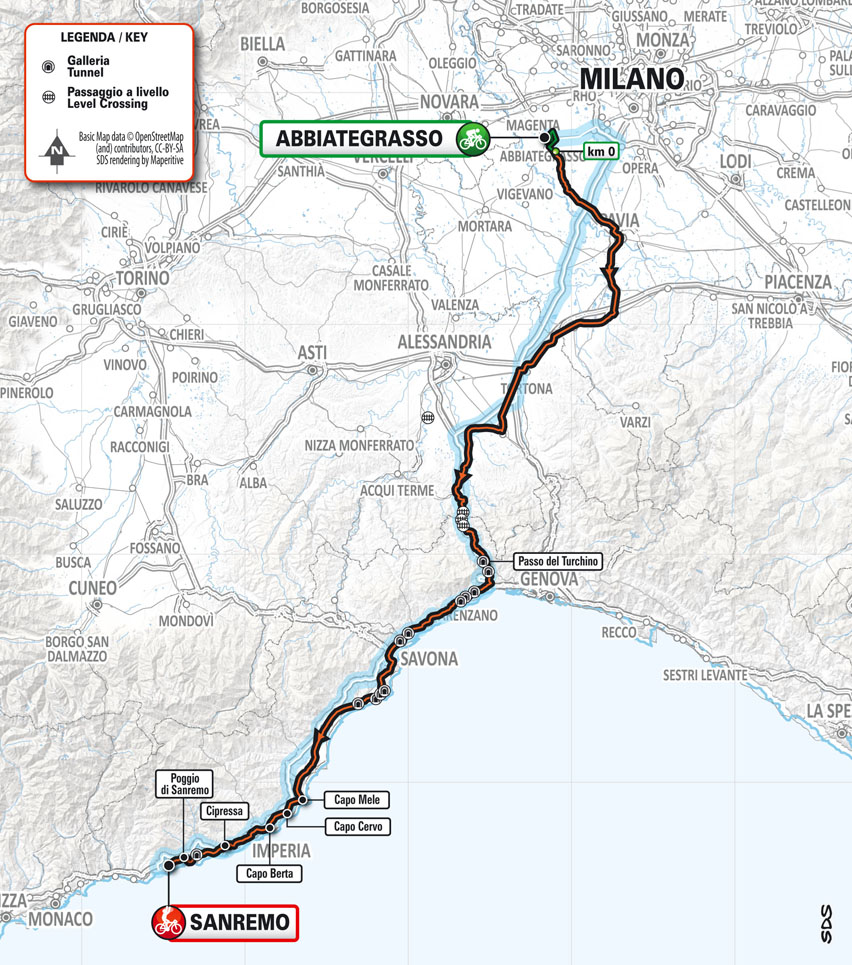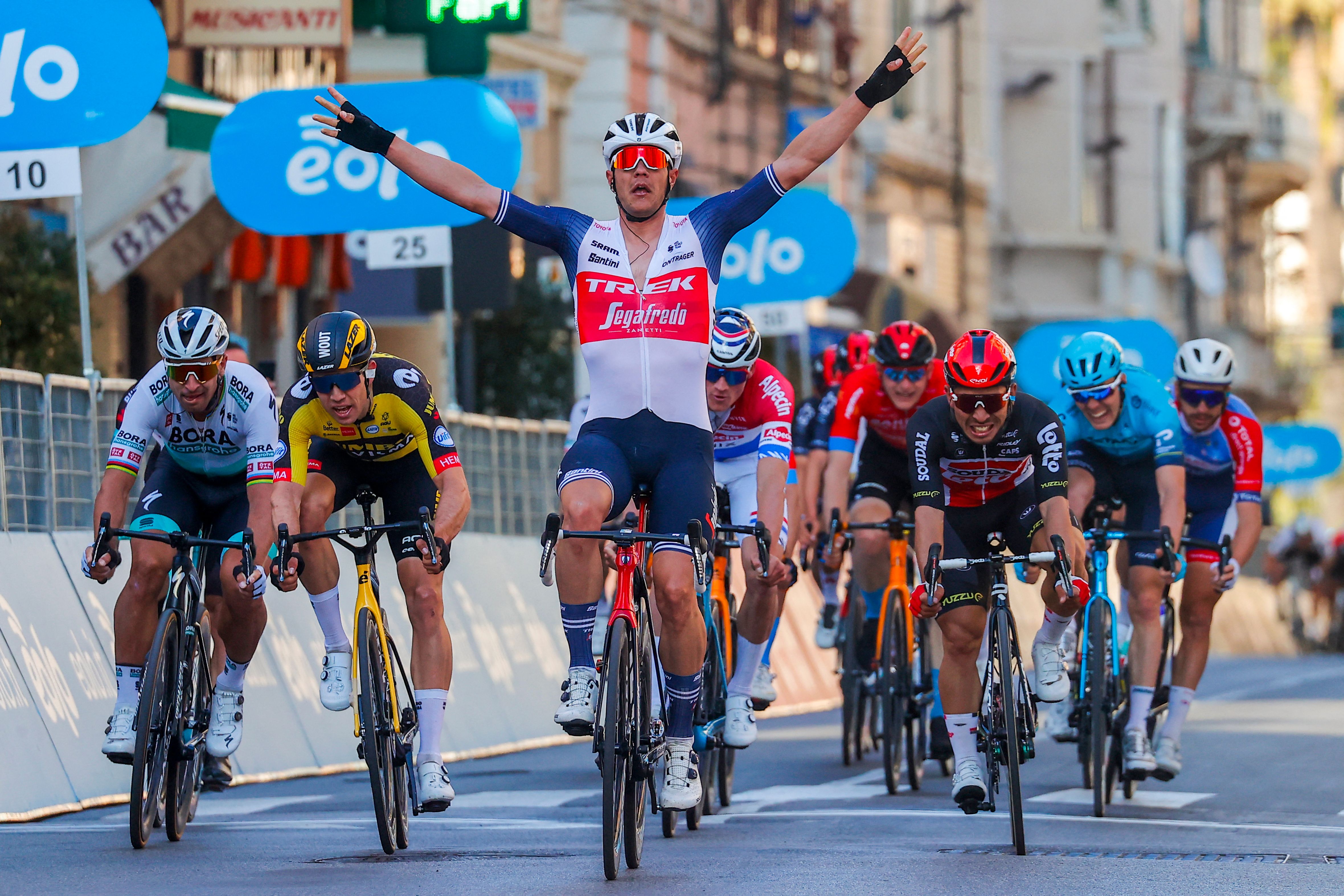Milan-San Remo 2023: Route and start list
All you need to know about the first Monument of the 2023 season

Milan-San Remo 2023 route

The longest Monument of the season, this year's Milan-San Remo takes place on Saturday 18 March and will showcase some of the world's best riders over a mammoth 294km.
The big news for this season a change in start location, to the town of Abbiategrasso, 22km south-west of Milan, where the race usually heads out from the city centre. The riders will rejoin the traditional route 30km into the race, from which point they will follow a well trodden route all the way to the finish on the famous Via Roma in San Remo. It will take them around six-and-a-half hours of riding.
Along the way riders will encounter the climb of the Passo Turchino at around the halfway mark, followed by the three small capi – the Capo Mele, Cervo and Berta – at around the 250km mark as the race approaches its finale. With 22km to go, riders crest the Cipressa (5.6km at 4.1%) and then finally, those who are left tackle the Poggio (3.7km at 3.7%). Often a small gap will go over the top – it then comes down to whether the escapees can cling on to their advantage on the sinuous descent and the flat 2km to the finish, or whether the chasing bunch can bring them back and unleash the sprinters within.

Milan-San Remo route history
Despite being known as the ‘Sprinters' Classic’, the Italian race would not be as prestigious as it is were it a straightforward procession to a bunch sprint, and instead the race is characterised by its tortuous length, thrilling conclusion and delicate balancing act between sprinters and attackers.
The introduction of La Manie in 2008 gave the advantage to attacking puncheurs, as a difficult, significantly-positioned climb to gain an advantage over those hoping for a bunch sprint. It contributed to a handful of more selective editions - Fabian Cancellara won from a solo break in 2008 and Simon Gerrans from a group of three in 2010, and in both 2011 and 2013 a group of seven contested the finish, won by Matt Goss and Gerald Ciolek respectively.
When La Manie was dropped in 2014, the organiser's initial intention had been to make the route even harder by replacing it with the Pompeiana in a slot far closer to the finish. But that climb was deemed unsafe due to the possibility of landslides, so since 2014, the race has featured neither climb.

Now, the dynamic of the route has shifted comprehensively back to the sprinters.
The latest race content, interviews, features, reviews and expert buying guides, direct to your inbox!
After Alexander Kristoff (then Katusha) won the sprint from a sizeable peloton in 2014, the finish was moved back to its traditional finishing straight of Via Roma, and another sprinter was triumphant in the form of John Degenkolb (then Giant-Alpecin) in 2015 and Arnaud Démare (Groupama-FDJ) in 2016.
For the bold and the brave, the Cipressa provides a potential launchpad for an attack at just over 20km from the finish, but for the more realistic, it’s the Poggio.
On the back of around 280km of racing the riders are exhausted upon reaching it, and, peaking at 5.5km from the finish, any rider who goes over the top first with a gap has a chance of zooming down the descent and holding off the sprinters for victory on the Via Roma.
Only two British riders have emerged victorious at the race, with Tom Simpson being the first back in 1964 for Peugeot-BP-Engelbert team. The next came several years later in 2009, when Mark Cavendish (then Team Columbia-High Road) took victory in a bunch sprint. British champion Ben Swift (Ineos Grenadiers) has come close on various occasions.
Milan-San Remo 2023 provisional start list
Team Jumbo-Visma
TRATNIK Jan
AFFINI Edoardo
LAPORTE Christophe
VALTER Attila
VAN AERT Wout
VAN HOOYDONCK Nathan
VAN EMDEN Jos
Soudal-Quick Step
SÉNÉCHAL Florian
ALAPHILIPPE Julian
LAMPAERT Yves
ASGREEN Kasper
BALLERINI Davide
DECLERCQ Tim
DEVENYNS Dries
UAE Team Emirates
POGAČAR Tadej
COVI Alessandro
WELLENS Tim
GROßSCHARTNER Felix
NOVAK Domen
TRENTIN Matteo
ULISSI Davide
AG2R Citroën
NAESEN Oliver
NAESEN Lawrence
COSNEFROY Benoît
SCHÄR Michael
HÄNNINEN Jaakko
VENDRAME Andrea
WARBASSE Larry
Trek-Segafredo
PEDERSEN Mads
CATALDO Dario
HOELGAARD Markus
MOSCA Jacopo
SKUJIŅŠ Toms
STUYVEN Jasper
VERGAERDE Otto
Bora-Hansgrohe
BENEDETTI Cesare
BENNETT Sam
DENZ Nico
HALLER Marco
MULLEN Ryan
POLITT Nils
VAN POPPEL Danny
Israel-Premier Tech
VANMARCKE Sep
GEE Derek
HOULE Hugo
NEILANDS Krists
WÜRTZ SCHMIDT Mads
IMPEY Daryl
STRONG Corbin
Groupama-FDJ
MOLARD Rudy
STEWART Jake
SCOTSON Miles
KONOVALOVAS Ignatas
PACHER Quentin
DÉMARE Arnaud
GENIETS Kevin
Team Jayco-AlUla
SOBRERO Matteo
PÖSTLBERGER Lukas
ŠTYBAR Zdeněk
MEZGEC Luka
HEPBURN Michael
MAAS Jan
BALMER Alexandre
Cofidis
CONSONNI Simone
WOOD Harrison
DELETTRE Alexandre
CIMOLAI Davide
COQUARD Bryan
RENARD Alexis
THOMAS Benjamin
Ineos Grenadiers
NARVÁEZ Jhonatan
KWIATKOWSKI Michał
HEIDUK Kim
GANNA Filippo
ROWE Luke
SHEFFIELD Magnus
SWIFT Ben
Astana Qazaqstan Team
SYRITSA Gleb
BASSO Leonardo
BOL Cees
CAVENDISH Mark
FEDOROV Yevgeniy
VELASCO Simone
RIABUSHENKO Alexandr
Bahrain Victorious
MOHORIČ Matej
BILBAO Pello
PASQUALON Andrea
CARUSO Damiano
MILAN Jonathan
WRIGHT Fred
ARNDT Nikias
Lotto-Dstny
VAN GILS Maxim
DRIZNERS Jarrad
EWAN Caleb
DE LIE Arnaud
DE BUYST Jasper
FRISON Frederik
GUARNIERI Jacopo
BETTIOL Alberto
WIŚNIOWSKI Łukasz
RUTSCH Jonas
POWLESS Neilson
HONORÉ Mikkel Frølich
CORT Magnus
BISSEGGER Stefan
Movistar Team
GARCÍA CORTINA Iván
MAS Lluís
JACOBS Johan
SERRANO Gonzalo
ARANBURU Alex
LAZKANO Oier
GAVIRIA Fernando
Team DSM
BITTNER Pavel
DINHAM Matthew
DEGENKOLB John
EECKHOFF Nils
MAYRHOFER Marius
STORCK Florian
VERMAERKE Kevin
Intermarché-Wanty-Gobert Matériaux
BYSTRØM Sven Erik
BONIFAZIO Niccolò
DE GENDT Aimé
ROTA Lorenzo
VLIEGEN Loïc
TEUNISSEN Mike
GIRMAY Biniam
DILLIER Silvan
VERMEERSCH Gianni
SBARAGLI Kristian
KRAGH ANDERSEN Søren
HERMANS Quinten
PHILIPSEN Jasper
VAN DER POEL Mathieu
TotalEnergies
FERRON Valentin
DUJARDIN Sandy
TURGIS Anthony
SOUPE Geoffrey
OSS Daniel
BODNAR Maciej
SAGAN Peter
Arkéa-Samsic
BARGUIL Warren
MOZZATO Luca
LOUVEL Matis
VERRE Alessandro
BIERMANS Jenthe
GUGLIELMI Simon
RUSSO Clément
Green Project-Bardiani-CSF-Faizanè
GABBURO Davide
TAROZZI Manuele
LUCCA Riccardo
TONELLI Alessandro
ZOCCARATO Samuele
MULUBRHAN Henok
MAGLI Filippo
Eolo-Kometa
MARTIN David
BEVILACQUA Simone
RIVI Samuele
MAESTRI Mirco
BAIS Mattia
GAVAZZI Francesco
SEVILLA Diego Pablo
Tudor Pro Cycling Team
THALMANN Roland
PLUIMERS Rick
KLUCKERS Arthur
HEMING Mika
CHARRIN Aloïs
BOHLI Tom
WIRTGEN Luc
Q36.5 Pro Cycling Team
PUPPIO Antonio
MOSCHETTI Matteo
LUDVIGSSON Tobias
FEDELI Alessandro
DONOVAN Mark
BRAMBILLA Gianluca
ABREHA Negasi Haylu
How to watch Milan-San Remo on TV
The race is broadcast on Eurosport and GCN Race Pass, with live coverage as well as a highlights package.
Our full guide on how to watch Milan - San Remo can be found here.
Elsewhere in the world, you can catch it live on Sporza (Dutch) and RTBF (French); Italy's Rai Sport 2 and SBS in Australia will also show footage.
You can follow the action via Twitter, via the handle @Milano_Sanremo.
Milan-San Remo: Recent winners
2021: Jasper Stuyven (Bel) Trek-Segafredo
2020: Wout van Aert (Bel) Jumbo-Visma
2019: Julian Alaphilippe (Fra) Deceuninck–Quick-Step
2018: Vincenzo Nibali (Ita) Bahrain-Merida
2017: Michal Kwiatkowski (Pol) Team Sky
2016: Arnaud Démare (Fra) FDJ
2015: John Degenkolb (Ger) Giant-Alpecin
2014: Alexander Kristoff (Nor) Katusha
2013: Gerald Ciolek (Ger) MTN-Qhubeka
2012: Simon Gerrans (Aus) GreenEdge
2011: Matt Goss (Aus) HTC-Highroad
2010: Oscar Freire (Spa) Rabobank
2009: Mark Cavendish (GBr) Columbia-Highroad
2008: Fabian Cancellara (Sui) CSC
2007: Oscar Freire (Spa) Rabobank
Previous editions: 2018 | 2017 | 2016 | 2015 | 2014 | 2013 | 2012 | 2011 | 2010 | 2009
Ryan is a staff writer for Cycling Weekly, having joined the team in September 2021. He first joined Future in December 2020, working across FourFourTwo, Golf Monthly, Rugby World and Advnture's websites, before making his way to cycling. After graduating from Cardiff University with a degree in Journalism and Communications, Ryan earned a NCTJ qualification to further develop as a writer.